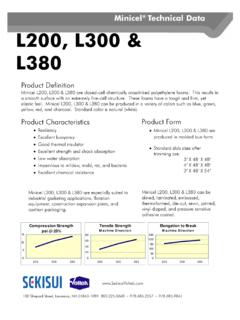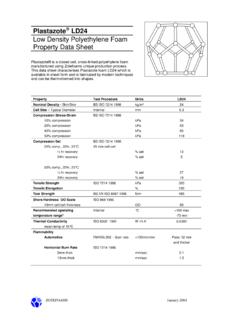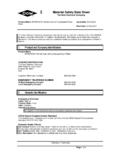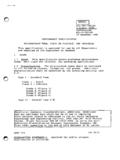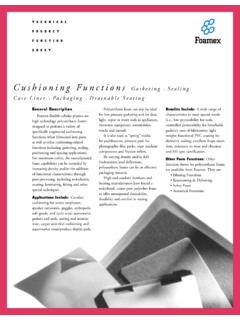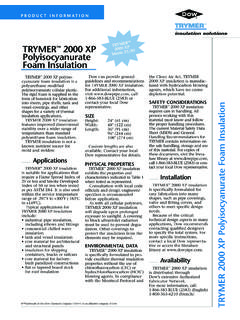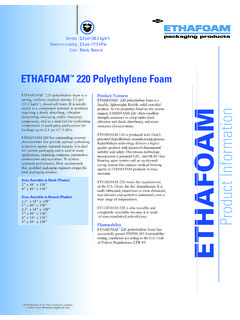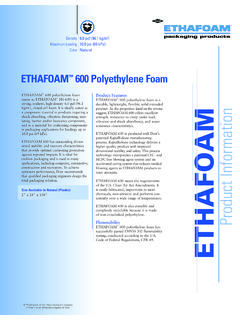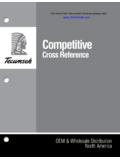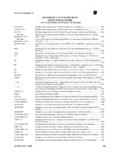Transcription of PPP-C-1752D(3) COMMERCIAL ITEM DESCRIPTION
1 [METRIC]A-A-5913628 OCTOBER 1997 SUPERSEDINGPPP-C-1752D(3)1 FEBRUARY 1993 COMMERCIAL ITEM DESCRIPTIONCUSHIONING MATERIAL, PACKAGING, CLOSED CELL FOAM PLANKThe General Services Administration has authorized the use of this COMMERCIAL item DESCRIPTION as a replacementfor Class 2 and Class 3 of PPP-C-1752D by all federal This COMMERCIAL item DESCRIPTION covers closed cell foam plank materials used for cushioning and packagingapplications, including static dissipative and fire retardant The selection of foam cushioning material is dependent on its application and factors such as drop height.
2 Product weight, thickness and derived dynamic performance while its application depends on environmentalfactors such as temperature, humidity, transportation and storage . Therefore, a variety of classes and gradesreflecting material characteristics are available. Refer to MIL-HDBK-304 for additional This standard does not purport to address the safety problems, if any, associated with its use. It is theresponsibility of the user of this standard to establish appropriate safety and health practices and determine theapplicability of regulatory limitations prior to Foam planks shall be of the following types, classes, and grades as 1 - General purpose polyethylene plank material (unskived).
3 Class 2 - General purpose polypropylene plank material (unskived).Class 3 - General purpose plank material, polymer specified by the Procuring Activity (unskived).Class 4 - Special purpose (skived) sheets, planks, and shapes as specified by the Procuring 8135 Beneficial comments, recommendations, deletions, clarifications, etc. and any other data which may improve thisdocument should be addressed to: AFMC LSO/LOP, 5215 Thurlow St., Wright-Patterson AFB OH A - B - Static C - Fire retardant (See ).Grade D - Static dissipative and Fire retardant (See ).
4 Type I - 14 Kg Constant Compression Creep, See III - 21 Kg Constant Compression Creep, See IV - 25 Kg Constant Compression Creep, See V- 37 Kg Constant Compression Creep, See SALIENT Terminology - General definitions for packaging and distribution environments are found in TerminologyASTM D Materials: The foam material supplied under this specification shall be suitable to protect items from hazardsencountered during handling and shipping at temperatures between -54 C (-65 F) and 70 C (158 F). Form - Material shall be furnished in the forms Plank Material (Class 1, 2 and 3) - Pieces of material which have a rectangular horizontal cross section anda nominal thickness of more than 13 Special Shapes (Class 4 only)
5 - Extruded, fabricated, and molded shapes, rounds, die cuts, and all otherpieces of polyethylene foam which meet the dimensional tolerances of Die cuts may consist of a single layer orseveral layers of cushioning material laminated together to reach the specified material Static Dissipative Material (Grades B and D) - Static dissipative material shall conform to all requirementsfor the specified type (See ), while continuing to meet the requirements of Electrostatic Decay time - The average decay time , when tested as specified in , shall be less than Surface Conductive Material - Surface resistivity, when tested as specified in , shall not be less x 105 and not more than x 1014 ohms per Fire-Retardant Material (Grades C and D) - Fire retardant material shall conform to all the requirementsspecified by the Procuring Activity for the specified type and class.
6 (See ) Dynamic Cushioning Properties (Types I, III, IV, and V) - The dynamic cushioning average points, whentested as specified in , shall lie entirely between the upper and lower limit curves of the applicable figure(Figures 1, 2, 3, and 4). Density - The nominal density of the material when tested as specified in shall be tested and otherwise specified the density will not be used to reject I - 32 Kg/M (2 PCF) Nominal Density Cushioning III - 64 Kg/M (4 PCF) Nominal Density Cushioning IV - 96 Kg/M (6 PCF) Nominal Density Cushioning V- 144 Kg/M (9 PCF) Nominal Density Cushioning Color.
7 For visual identification purposes Grade A - The color shall be Grade B - The color shall be Grade C - The color shall be light Grade D - The color shall be Dimensional Tolerances -Unless otherwise specified, the following tolerances apply ( ):CLASSLENGTH (%)WIDTH (%)THICKNESSGENERAL PURPOSE PLANK1, 2, 3+6, -0+8, -0+20 %, -5 %SPECIAL PURPOSE SHEETS, PLANKS, AND SHAPES4+6, -0+8, -0 2 Constant Compression Creep - The average creep shall be not greater than 10 percent of the initial thicknessafter testing for 168 hours as specified in Sample size 50mm x 100mm x 100mm.
8 Use the applicable loads asfollows:Material TypeStatic Load (Kg)I14 III21IV25V374. REGULATORY REQUIREMENTS - NONE5. QUALITY ASSURANCE Contractor Certification. The contractor shall certify and maintain all records in accordance with the contractconditions and applicable Federal Acquisition Requirements (FAR) First Article Wavier. First article inspection may be waived, by the Air Force Packaging Technology andEngineering Facility (AFPTEF) or the procuring activity, when the procuring activity or contract administrator hasdata or other evidence to indicate that prior successful first article inspection has been conducted.
9 Only when thefirst article has been waived by the AFPTEF or procuring activity, may the contractor self-certify that the materialwill conform to the requirements of this First Article Inspection. First article inspection shall consist of all tests in this section and shall beperformed by the contractor prior to production. First article inspection shall be performed on sample unitsproduced using materials, equipment, and procedures which will be used in fulfilling the contract. First articleapproval is valid only on the contract on which it is granted , unless extended by the Government to othercontracts.
10 In case of dispute, the procuring activity shall require testing on contractor supplied material performedby either AFPTEF or an independent Market Acceptability. The following market acceptability criteria are necessary to document the quality of theproduct to be provided under this Manufacturer Purchase. The materials manufacturer shall furnish documents that the material being offeredis a COMMERCIAL product meeting the requirements of this CID. Such proof could be completed delivery ordersfilled for customers within the previous 12 Purchase from a distributor.
![[METRIC] A-A-59135 28 OCTOBER 1997 …](/cache/preview/1/6/7/b/c/f/8/3/thumb-167bcf835901dc5cad2c4031ca7a4001.jpg)
